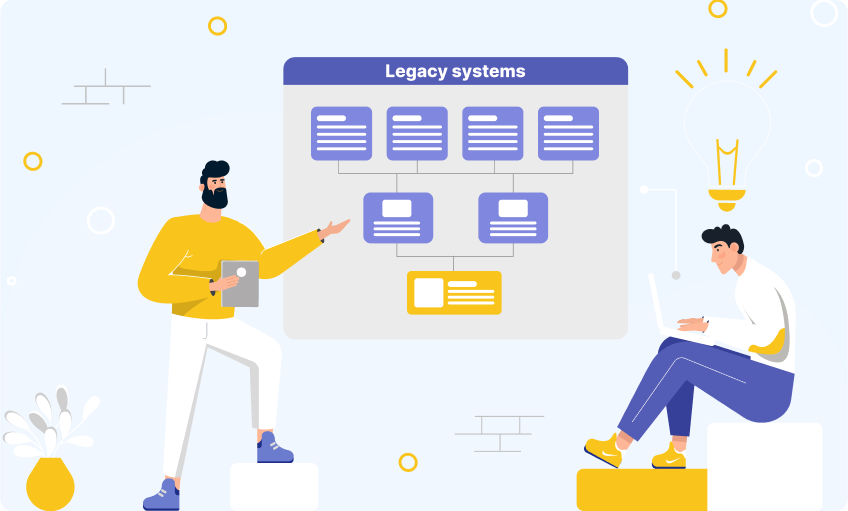Published - 3 months ago | 6 min read
Replatforming vs Rebuilding: How to Choose the Right Legacy Modernization Strategy
Every organization that relies on software eventually faces the same challenge: systems that once worked well no longer keep up with today’s demands. Applications that were efficient ten years ago may now be expensive to maintain, difficult to integrate, and slow to adapt. Modernization becomes unavoidable.
When leaders begin this journey, they often hear about two strategies: replatforming and rebuilding. Both are valid, both can deliver strong results, but they involve very different levels of investment, disruption, and long-term benefit.
This article explores the differences in detail. We will look at what replatforming means in practice, when it is appropriate, and how companies can cut costs while making the transition. We will also examine rebuilding from the ground up, including the risks and rewards, and provide a framework for making the right decision for your business.
When leaders begin this journey, they often hear about two strategies: replatforming and rebuilding. Both are valid, both can deliver strong results, but they involve very different levels of investment, disruption, and long-term benefit.
This article explores the differences in detail. We will look at what replatforming means in practice, when it is appropriate, and how companies can cut costs while making the transition. We will also examine rebuilding from the ground up, including the risks and rewards, and provide a framework for making the right decision for your business.
Why Legacy Modernization Matters
Legacy systems are more than just “old software.” They carry real costs:
- Higher spending on maintenance and patching
- Inflexibility when integrating with modern platforms
- Slower feature delivery, which affects competitiveness
- Increased security exposure from outdated technologies
Modernization is not optional once these issues start to limit growth. The question is how to modernize in a way that balances cost, risk, and business goals. That is where replatforming and rebuilding enter the conversation.
- Higher spending on maintenance and patching
- Inflexibility when integrating with modern platforms
- Slower feature delivery, which affects competitiveness
- Increased security exposure from outdated technologies
Modernization is not optional once these issues start to limit growth. The question is how to modernize in a way that balances cost, risk, and business goals. That is where replatforming and rebuilding enter the conversation.

What is Replatforming?
Replatforming is the process of moving an application to a modern runtime environment with minimal code changes. The goal is to adapt the system so it can run on a newer platform, often a cloud provider, without altering its core logic or features.
According to Gartner’s definition, replatforming involves migrating components to a new environment while making only the changes necessary for compatibility and efficiency. It is not a full rewrite.
According to Gartner’s definition, replatforming involves migrating components to a new environment while making only the changes necessary for compatibility and efficiency. It is not a full rewrite.
Characteristics of Replatforming
- Scope of change: Limited. Most code and features remain the same.
- Cost and time: Usually about half the cost of a rebuild, often completed within a few months.
- Risk level: Moderate, because the application logic is preserved.
- Customization: Limited. You can optimize configurations and integrations, but not the fundamental design.
- Impact on users: Minimal. Interfaces and workflows usually remain familiar.
- Cost and time: Usually about half the cost of a rebuild, often completed within a few months.
- Risk level: Moderate, because the application logic is preserved.
- Customization: Limited. You can optimize configurations and integrations, but not the fundamental design.
- Impact on users: Minimal. Interfaces and workflows usually remain familiar.
When to Replatform
Replatforming makes sense when:
- The application is still functionally reliable but hosted on outdated infrastructure.
- The organization needs a faster return on investment.
- There is limited appetite for risk or long downtime.
- Teams want to preserve familiar workflows for both staff and customers.
For example, a financial services company running an on-premises application may replatform it to a cloud provider. The application logic does not change, but the company gains scalability, managed services, and reduced operating costs.
- The application is still functionally reliable but hosted on outdated infrastructure.
- The organization needs a faster return on investment.
- There is limited appetite for risk or long downtime.
- Teams want to preserve familiar workflows for both staff and customers.
For example, a financial services company running an on-premises application may replatform it to a cloud provider. The application logic does not change, but the company gains scalability, managed services, and reduced operating costs.
How to Control Costs During Replatforming
Even though replatforming is less expensive than a rebuild, budgets are still tight. Careful planning helps maximize the value of the migration. Here are strategies that experienced teams apply:
1. Leverage lift-and-shift tools first. Start by moving the system with minimal disruption, then refine after stability is achieved.
2. Optimize cloud pricing models. Use pay-as-you-go for variable workloads and reserved instances for predictable demand.
3. Use managed services. Database hosting, caching, and messaging offered by providers reduce licensing and staffing costs.
4. Adopt Infrastructure as Code. Automating deployment with Terraform or ARM templates reduces configuration errors and repetitive labor.
5. Enable lifecycle policies. Move infrequently accessed data to cold storage tiers automatically.
6. Monitor costs continuously. Cloud cost dashboards ensure resources are sized correctly and prevent waste.
These practices let companies enjoy the benefits of replatforming while avoiding common overspending traps.
1. Leverage lift-and-shift tools first. Start by moving the system with minimal disruption, then refine after stability is achieved.
2. Optimize cloud pricing models. Use pay-as-you-go for variable workloads and reserved instances for predictable demand.
3. Use managed services. Database hosting, caching, and messaging offered by providers reduce licensing and staffing costs.
4. Adopt Infrastructure as Code. Automating deployment with Terraform or ARM templates reduces configuration errors and repetitive labor.
5. Enable lifecycle policies. Move infrequently accessed data to cold storage tiers automatically.
6. Monitor costs continuously. Cloud cost dashboards ensure resources are sized correctly and prevent waste.
These practices let companies enjoy the benefits of replatforming while avoiding common overspending traps.
What is Rebuilding?
Rebuilding takes modernization much further. In this strategy, the legacy application is discarded as a base and rewritten from scratch, often using microservices or serverless architectures.
The scope includes redesigning business logic, data models, and user experience to align with current and future needs. While it is the most demanding path, it also provides the greatest long-term flexibility.
The scope includes redesigning business logic, data models, and user experience to align with current and future needs. While it is the most demanding path, it also provides the greatest long-term flexibility.
Characteristics of Rebuilding
- Scope of change: Complete. Every aspect of the application is re-created.
- Cost and time: Highest investment, often a year or more of work.
- Risk level: High, due to the scale of change and the need for new testing and validation.
- Customization: Unlimited. The design can match modern business and technical requirements precisely.
- Impact on users: Significant. Interfaces and processes often change, sometimes dramatically.
- Cost and time: Highest investment, often a year or more of work.
- Risk level: High, due to the scale of change and the need for new testing and validation.
- Customization: Unlimited. The design can match modern business and technical requirements precisely.
- Impact on users: Significant. Interfaces and processes often change, sometimes dramatically.
When to Rebuild
Rebuilding is the right choice when:
- The legacy system no longer meets business objectives.
- Maintenance costs are unmanageable.
- Technical debt prevents meaningful upgrades.
- The system poses unacceptable risks in security or compliance.
- The organization wants to redesign the experience, not just maintain it.
An example is a healthcare provider running a 20-year-old scheduling system that cannot support modern integrations, mobile access, or compliance features. Rebuilding allows them to start fresh with an architecture designed for today’s realities.
- The legacy system no longer meets business objectives.
- Maintenance costs are unmanageable.
- Technical debt prevents meaningful upgrades.
- The system poses unacceptable risks in security or compliance.
- The organization wants to redesign the experience, not just maintain it.
An example is a healthcare provider running a 20-year-old scheduling system that cannot support modern integrations, mobile access, or compliance features. Rebuilding allows them to start fresh with an architecture designed for today’s realities.
How to Control Costs During Rebuilding
Rebuilding is resource-intensive, but careful strategies reduce the burden and increase the likelihood of success:
1. Apply the Strangler Fig pattern. Replace legacy components step by step with new microservices while keeping the old system partially running.
2. Develop a Minimum Viable Product. Focus on critical features first to validate assumptions and generate early business value.
3. Use proven open-source frameworks. Node.js, Spring Boot, and .NET Core reduce development time and avoid costly proprietary solutions.
4. Adopt containerization early. Packaging services with Docker or Kubernetes ensures consistency and simplifies scaling.
5. Automate CI/CD and testing. Automated pipelines catch errors quickly and reduce costly rework later in the cycle.
6. Engage offshore or nearshore partners. Outsourcing non-core components can stretch budgets while maintaining quality.
7. Monitor cloud usage carefully. Continuous right-sizing of instances prevents runaway costs.
These measures help teams build robust, modern applications without exhausting budgets or timelines.
1. Apply the Strangler Fig pattern. Replace legacy components step by step with new microservices while keeping the old system partially running.
2. Develop a Minimum Viable Product. Focus on critical features first to validate assumptions and generate early business value.
3. Use proven open-source frameworks. Node.js, Spring Boot, and .NET Core reduce development time and avoid costly proprietary solutions.
4. Adopt containerization early. Packaging services with Docker or Kubernetes ensures consistency and simplifies scaling.
5. Automate CI/CD and testing. Automated pipelines catch errors quickly and reduce costly rework later in the cycle.
6. Engage offshore or nearshore partners. Outsourcing non-core components can stretch budgets while maintaining quality.
7. Monitor cloud usage carefully. Continuous right-sizing of instances prevents runaway costs.
These measures help teams build robust, modern applications without exhausting budgets or timelines.

Comparing Replatforming and Rebuilding
To make an informed decision, leaders need a side-by-side view of the two strategies.

Replatforming is generally chosen when the system still performs its job but needs better infrastructure. Rebuilding is chosen when the system’s limitations are so severe that only a fresh start will work.
Step-by-Step Modernization Planning
Whichever strategy you choose, modernization should follow a structured plan. Experienced teams recommend:
1. Assess current systems. Inventory applications, dependencies, performance, and security gaps.
2. Define business objectives. Clarify whether the priority is cost reduction, new features, faster time-to-market, or compliance.
3. Engage stakeholders. Align technical planning with operations, finance, and business units.
4. Select the strategy. Match replatforming or rebuilding to the objectives, resources, and risk tolerance.
5. Design the target architecture. Establish cloud models, integrations, and data governance before execution.
6. Execute in phases. Break work into manageable stages, validating at each step.
7. Monitor and refine. Use DevOps pipelines to measure performance, costs, and user experience continuously.
This disciplined approach reduces surprises and helps modernization succeed.
1. Assess current systems. Inventory applications, dependencies, performance, and security gaps.
2. Define business objectives. Clarify whether the priority is cost reduction, new features, faster time-to-market, or compliance.
3. Engage stakeholders. Align technical planning with operations, finance, and business units.
4. Select the strategy. Match replatforming or rebuilding to the objectives, resources, and risk tolerance.
5. Design the target architecture. Establish cloud models, integrations, and data governance before execution.
6. Execute in phases. Break work into manageable stages, validating at each step.
7. Monitor and refine. Use DevOps pipelines to measure performance, costs, and user experience continuously.
This disciplined approach reduces surprises and helps modernization succeed.
Trends Shaping Modernization Choices
Current industry practices reveal several trends:
- Hybrid approaches are common. Some organizations replatform parts of a system while rebuilding others, balancing speed with long-term flexibility.
- Cloud-native services are the norm. Few companies invest in modernization without adopting managed databases, container platforms, and cloud security.
- Automation is expected. Infrastructure as Code, CI/CD, and automated testing are considered baseline practices, not optional extras.
- Cost governance is central. Modernization projects that succeed build financial monitoring into every stage.
Understanding these trends helps leaders benchmark their strategies against peers.
- Hybrid approaches are common. Some organizations replatform parts of a system while rebuilding others, balancing speed with long-term flexibility.
- Cloud-native services are the norm. Few companies invest in modernization without adopting managed databases, container platforms, and cloud security.
- Automation is expected. Infrastructure as Code, CI/CD, and automated testing are considered baseline practices, not optional extras.
- Cost governance is central. Modernization projects that succeed build financial monitoring into every stage.
Understanding these trends helps leaders benchmark their strategies against peers.
Conclusion
Legacy modernization is not a single decision but a choice between different levels of investment and transformation. Replatforming provides a practical, lower-risk path when the application still functions but requires updated infrastructure. Rebuilding is a comprehensive strategy that eliminates technical debt and positions the business for long-term innovation. The right choice depends on your system’s condition, business goals, and risk tolerance. A structured approach, starting with assessment, aligning objectives, and executing in phases, ensures that whichever path you select delivers measurable business value. Modernization is challenging, but with the right strategy, it becomes a foundation for growth rather than a burden to maintain.

Written by / Author
Manasi Maheshwari
Found this useful? Share With
Top blogs
Most Read Blogs
Wits Innovation Lab is where creativity and innovation flourish. We provide the tools you need to come up with innovative solutions for today's businesses, big or small.
© 2025 Wits Innovation Lab, All rights reserved
Crafted in-house by WIL’s talented minds

